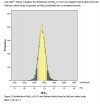First thing to say is well done on the reduction. Something's working well. 42 mmol/mol is only just out of the 38-42 normal non-diabetic range, and with the allowable error in the test it's entirely possible you're in normal range already. The HbA1c looks back about three months and gives you a sort of average picture of how your blood glucose was, with a skew towards the most recent weeks. So again, your current BG may have improved from the position three months back.
Second point would be to separate the fingerprick readings (given in mmol/l) from the HbA1c results (in mmol/mol). The fingerprick readings are a snapshot of where you are right at the moment you took the test. That figure is only explicable with the knowledge of what you were doing at the time. So it will vary depending on many things - first thing in the morning, whether you've eaten recently, if you're ill, how many carbs were in what you last ate, exactly how long ago you ate etc. "Normal" for a non-diabetic person is usually quoted as somewhere between 4.0 and 7.8 mmol/l depending on circumstances (mainly whether the test is done fasted or not).
Normal blood sugar ranges and blood sugar ranges for adults and children with type 1 diabetes, type 2 diabetes and blood sugar ranges to determine diabetes.

www.diabetes.co.uk
The example I always quote is of me having a small latte. I was using a CGM at the time which is the only reason I know how this went. I started off at 5.4mmol/l. 20 minutes after drinking the latte I was at 8.7. One hour after the latte I was at 5.3. So in that single hour I had both elevated and normal readings - but the lesson for me was that my system can currently deal with the carbs in a small latte.
If I'd done a fingerprick test after 20 minutes I might have thought I couldn't handle a latte at all. If I'd only tested after an hour I might have thought the latte had no impact at all on my BG.
It would be great if you could take your fingerprick readings and average them to convert to HbA1c. Unfortunately it doesn't work like that. The fingerprick readings will give a reasonable indication of how you're doing - eg if all your post-meal readings are genuinely under 7.8 it would be surprising if your HbA1c didn't reflect that. But because fingerpricks you only get info from the testing points, it's possible that you may miss highs and lows - when you're asleep, for instance. That's OK, because the HbA1c will pick that up.
The analogy is the satnav (fingerprick) and the map (HbA1c). The satnav tells you where you are right now and whether to turn right or left at the next junction. But from time to time you check the map, because the satnav doesn't tell you your general direction, and if you're seeing signs for Scotland when you wanted to drive to Cornwall, maybe there's something not quite right.
I went from an HbA1c of 50 (on diagnosis) to 38 four months later, and it's stayed around there since. I was lucky, and it did get rid of almost all my diabetic symptoms at the same time. I did go hardcore 20g carb/day, but that's neither essential nor practical for everyone. You need to find out what works for you - looks like what you're doing now is working.
best of luck!



